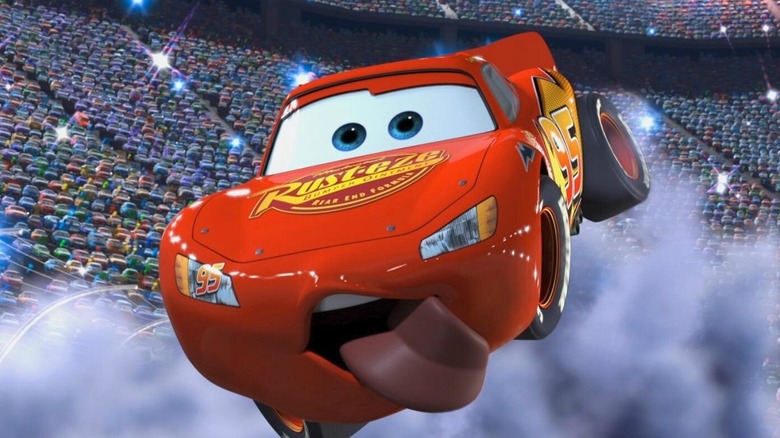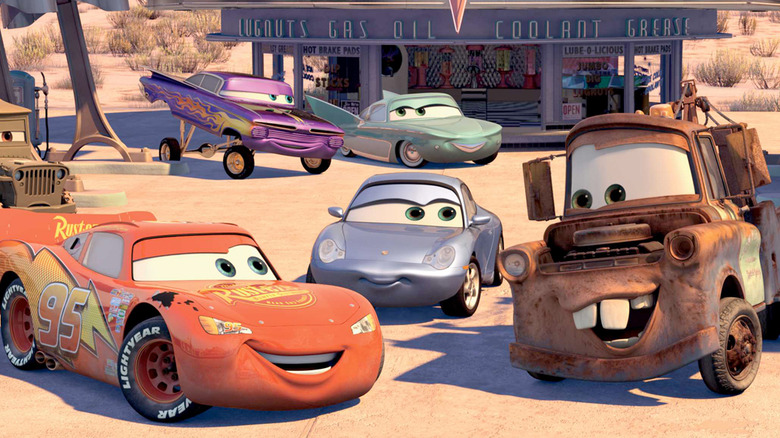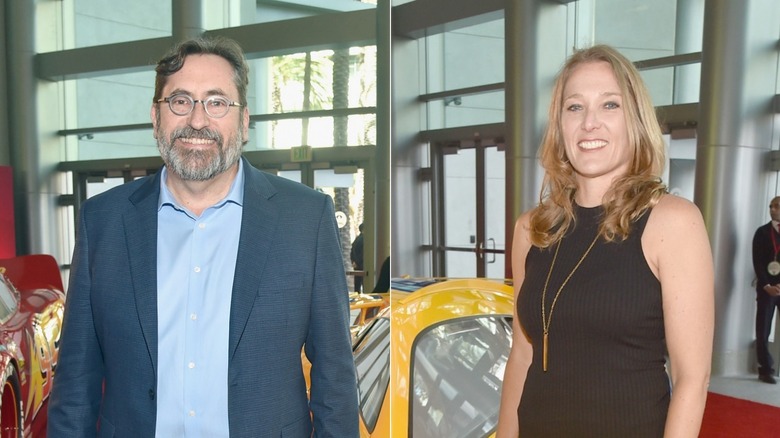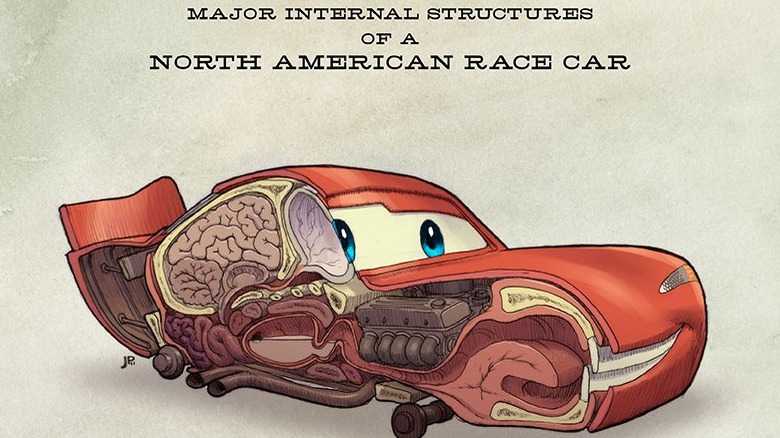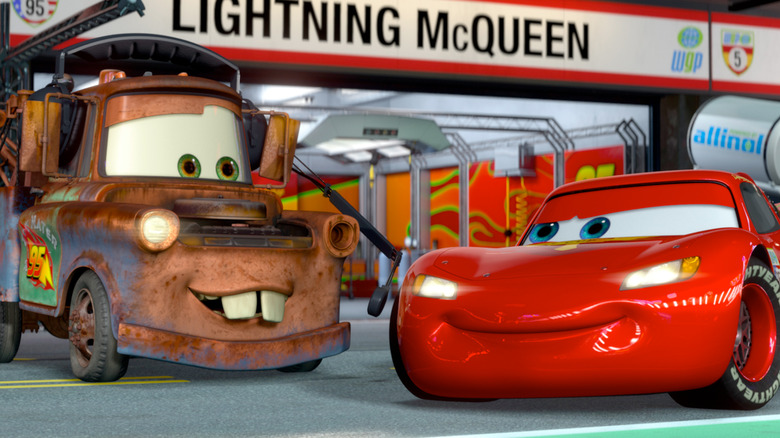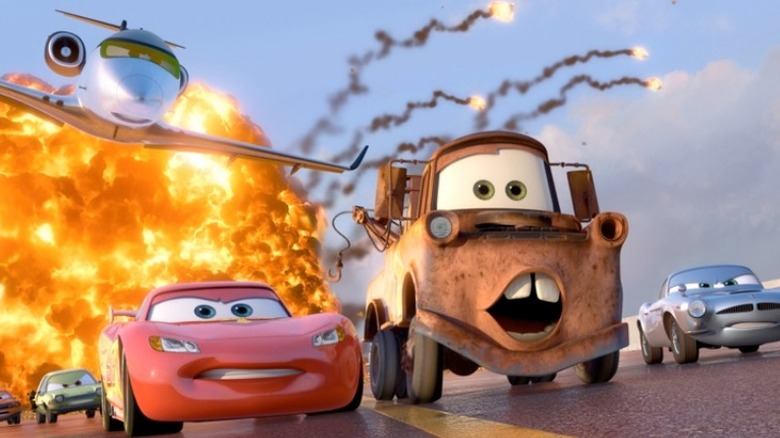Pixar Actively Avoids Explaining Where 'Cars' Come From, But A Wild, Disturbing Theory Offers Insight
This summer brings the release of Cars 3 in theaters, and based on the roughly 50 minutes of footage shown to us at Pixar Animation's campus in Emeryville, California, it just might be the best in the franchise yet. However, even though this is the third film in the animated franchise, there are still a lot of lingering questions about the world of Cars itself.
Most audiences have simply accepted the fact that Cars is about various vehicles (cars, trucks, planes, trains, boats, etc) which happen to be sentient and anthropomorphized. After all, there are countless animated movies about talking animals, bugs, toys and even household appliances, so a movie about some talking cars shouldn't be seriously questioned, right?
Well, what sets Cars apart from those other animated movies is that humans still exist and play an integral part of those movies. But in Cars, the only living things are other vehicles, and they seem to have a built a society not unlike that of humanity. There's capitalism, infrastructure, and a system of rules in place. But how did this world come to be? Let's explore a new theory regarding where Pixar Cars come from and why they actively avoid giving an explanation in the franchise.
What's So Perplexing About the World of Cars?
Perhaps the biggest hurdle the world of Cars is trying to understand where these sentient vehicles come from. After all, there are no baby vehicles in the Cars franchise. Think about it! There are no children in the world of Cars. There are vehicles who are older or younger than other each other, but there is no evidence of there ever being infant Cars that grow up in adult vehicles. That means Cars apparently don't reproduce the way humans do.
So if Cars don't reproduce, then where do they come from? Somewhere in the franchise there's a throwaway line where someone says "Thank the manufacturer," implying that there's some kind of higher power who created the Cars. That would be totally acceptable since there are billions of people in the real world who believe there is some kind of higher power responsible for creating humanity. And since Cars 2 features vehicles fawning over the Popemobile in Italy, it appears there is at least one form of religion in the Cars universe. But even knowing that's a possibility, there's still no explanation of how Cars are born.
Why Isn't This Question More Directly Addressed?
With no clear explanation as to where Cars come from, the question is why doesn't Pixar give any inkling of an explanation as to where Cars come from within the narrative of the franchise? The answer is that trying to provide some of these explanations would require going into some weird, awkward and potentially gross territory.
I asked about where Cars come from during my interview with writers Bob Peterson and Kiel Murray (both pictured above) and story supervisor Scott Morse, and there was no definitive answer to the question, but they did indicate that it's something they've purposefully tried to avoid. Morse said:
"We try not to go there. We just try not to go there. There's a surreal level of disbelief that you're having to jump already coming into the world where there are talking cars. We think we know what cars are in our world, and they serve a completely different purpose in the Cars world. They're for transportation [in our world] and they don't really transport each other in their world. So they become characters. We lean into that as much as we can and try not to get too hung up on the surreal nuts and bolts of it, I guess."
Bob Peterson interjected and said the world itself does create some interesting problems. For example:
"Even Cars kissing is like – clank – hitting metal together. It's funny because you have these hunks of metal, but at some point you can't take it too far because it starts falling apart."
However, that's not to say that it's something the creative minds at Pixar haven't thought about. Peterson went on to explain:
"Some of the story artists had fun with it. They draw cross-sections of the car with a person who's in there, and you can see his eyes. It's just some sort of mutant-like human that's driving this thing."
That sounds drastically different than what Jake Parker, the comic artist and designer who worked on Titan A.E. and Rio, came up with his for his "Automobile Anatomy" illustrations, which you can see below...
A Look Under The Hood
Kiel Murray chimed in and explained that the origin of Cars was something they discussed a lot more when they were working on the first movie. And the determining factor in how in-depth they decided to get in explaining where Cars come from was how weird it got. She said they "went by feel" when discussing this part of Cars. Some artists would storyboard something, and if it made too many people feel weird, they would scrap it.
The world is not something that is easily explained, and Murray says even some of the more seemingly simple design questions about Cars were complicated questions. Murray says, "I remember how much thought went into them getting gas, like the contraption of the arm at the gas station. And there was way too much time spent on that, let alone babies or God."
Scott Morse laid out the definitive reason that they don't approach these complex questions in the world of Cars, "I guess if it's not important to our main characters, it's fleshing it out in ways where we try not to look there."
But again, that doesn't mean Pixar hasn't thought about these questions, and thankfully, Cars franchise creative director Jay Ward offered his own theory as to where Cars come from.
A Theory About the Origin of Cars
ScreenCrush's Matt Singer was one of the many reporters attending the big press day (along with myself) for Cars 3, and he was able to get an outstanding, though ultimately still perplexing and even disturbing, answer about the origins of the world of Cars. Here's what Jay Ward had to say:
"If you think about this, we have autonomous car technology coming in right now. It's getting to the point where you can sit back in the car and it drives itself. Imagine in the near-future when the cars keep getting smarter and smarter and after one day they just go, 'Why do we need human beings anymore? They're just slowing us down. It's just extra weight, let's get rid of them.' But the car takes on the personality of the last person who drove it. Whoa. There you go."
So humans are the ones responsible for making the Cars sentient, and much like countless sci-fi movies about sophisticated artificial intelligence and robots, they turn on humanity and get rid of them. As a final nail in our coffin, they take on our personalities and carry on as if the world was their own. That's pretty dark.
Keep in mind, this is nothing more than a theory from Jay Ward and not meant to be taken as the definitive explanation for where the world of Cars comes from. But since he's responsible for an internal document at Pixar called "The World of Cars Owner's Manual," he's easily the most trusted source on the matter.
More Questions Than Answers
Though this explanation is somewhat satisfying, it still raises more questions than answers. For example, even though cars are getting smarter with advanced technology inside of them, how does a character like Mater exist then? Clearly his tow truck wasn't a smart car, so how did the tow truck come to be sentient?
Furthermore, if Cars just suddenly took over the world from humans, how long did it take them to adapt the world to their own needs? Cars don't have opposable thumbs and they surely couldn't access certain parts of the human world without drastically revamping them simply so they could fit.
Plus there are still the questions that have been asked since the beginning of the Cars franchise regarding the existence of other living things on the planet like animals. It looks like cows have an equivalent in the form of brainless tractors, but how did those tractors even come to exist in this world? Does every animal have a car equivalent? We see a Volkswagen Beetle and several other cars as bugs in the Cars world's version of A Bug's Life, but does that mean bugs are also cars in this world?
There are planes who have been to war in the world of Cars. Just what kind of wars have these planes fought and what were they about? Are planes the only vehicles that go to war? There's an Army Jeep that lives in Radiator Springs, so is he a veteran of these wars?
Seriously, there are endless questions about how the world of Cars operates, and while we certainly won't get any definitive answers to them from Pixar, but it's still fun to think about all the unanswered questions there are about this world of sentient vehicles.
Will Cars 3 end up raising even more questions? We'll find out when the sequel arrives on June 16.
